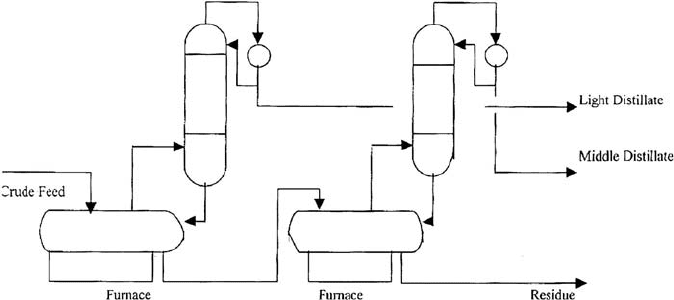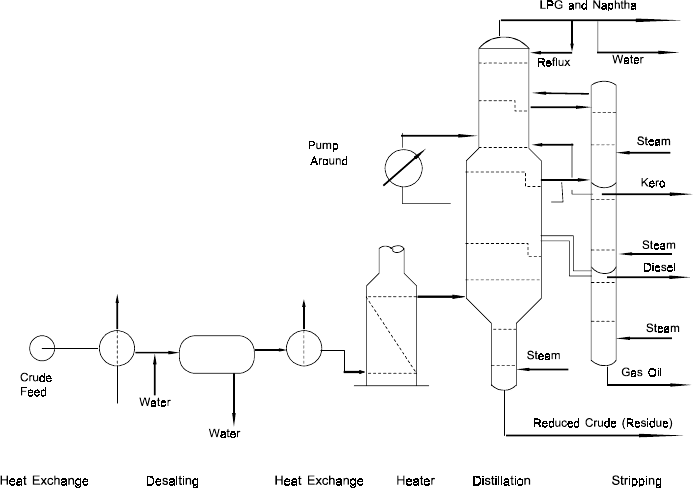Jones D.S.J., Pujado P.R. Handbook of Petroleum Processing
Подождите немного. Документ загружается.

1086 CHAPTER 19
70 grade—RC/MC/SC 70–140 Cs @ 140
◦
F.
250 grade—RC/MC/SC 250–500 Cs
800 grade—RC/MC/SC 800–1,600 Cs
3,000 grade—RC/MC/SC 3,000–6,000 Cs.
Rapid curing cutbacks are penetration asphalt and naphtha blends having a viscosity
range from 75 SSF @ 77
◦
F to 600 SSF @ 180
◦
F. The naphtha content may be as high
as 75 vol%. Cutbacks are hot sprayed onto existing roads as a binding medium for
new wearing surfaces.
Medium curing cutbacks are penetration grade asphalt and kerosene blends with four
grades having the same viscosities as the RC cutbacks. These are used in road building
in the same way as the RC cutbacks.
Slow curing cutbacks are penetration asphalt and gas oil blends normally produced
directly from the crude oil atmospheric or vacuum distillation. The volume produced
is small and they are used mainly as a gravel dust layer or mixed with aggregates for
cold patching of asphalt surfaces.
Roofing asphalt
The second largest asphalt use is that for roofing. Most of these asphalts are pro-
duced by air blowing. There are three major roofing grades and may be classified by
penetration and softening points. These are:
Pen@77
◦
F Softening point
◦
F
Type 1 25–50 140–150
Type 2 20–30 166–175
Type 3 15–25 190–205
Type 1 grade is used on ‘Dead Flat’roof while the other two are used on intermediate
and steep slope roofs, respectively.
Asphalt blowing process
Blowing air into a vessel containing asphalt from vacuum distillation or the de asphalt-
ing process will change its penetration and softening properties. Among the variables
that affect the manufacture of air blown asphalt are:
r
The rate of the air injected
r
The temperature of the asphalt
r
Retention time of the asphalt
r
The system pressure
A DICTIONARY OF TERMS AND EXPRESSIONS 1087
Description and details of this process are given in Chapter 12 in of this
Handbook.
Asphaltenes
Asphalt is basically a colloidal dispersion of asphaltenes in oil with resins as the
stabilizing agent. The quantities of these can vary widely with the type of crude.
Asphaltenes can be hydrogenated to resins, resins to oils. Resins can be oxidized to
asphaltenes, oil to resins. Thus:
Asphaltenes + H
2
H
2
→ Oil
+
Resins
+
Asphaltenes + O
2
O
2
+ Oil
Oxidation is really a misnomer, as air blown asphalt has essentially the same oxygen
content as the charge. Air blowing asphalt increases the asphaltene content, hardens it,
decreases penetration, increases softening, and reduces ductility. Basically air blowing
is a polymerization process following the route below:
1. Addition of O
2
to form unstable compounds from which H
2
O is eliminated leaving
unsaturated compounds which polymerize.
2. Addition of O
2
to form carboxyl derivatives from which CO
2
is eliminated followed
again by polymerization.
3. Formation and elimination of volatile oxidation products other than H
2
O and CO
2
followed again by polymerization.
It is worth noting, that the best crudes for asphalt air blowing are those with high
percentage of asphaltene fraction and low in paraffin hydrocarbons, and waxes. Resins
can be oxidized to asphaltenes relatively easily, so crudes rich in resin are good raw
materials for asphalt manufacture. Oils can also be oxidized to asphaltenes, but they
must be oxidized to resins first, which requires a more severe operation. Cracked
residua simply do not make good asphalt.
Assay: The crude
The crude oil assay is a compilation of laboratory and pilot plant data that define
the properties of the specific crude oil. At a minimum, the assay should contain a
distillation curve for the crude and a specific gravity curve. Most assays however
contain data on pour point (flowing criteria), sulfur content, viscosity, and many other
properties. The assay is usually prepared by the company selling the crude oil, it is used
1088 CHAPTER 19
extensively by refiners in their plant operation, development of product schedules, and
examination of future processing ventures. Engineering companies use the assay data
in preparing the process design of petroleum plants they are bidding on, or having
been awarded the project, they are now building.
The data normally contained in a well produced assay will be:
r
A TBP curve
r
A specific gravity curve
r
A sulfur content curve
r
A pour point and cloud point curve
r
Product tables of some of the lighter products. These should contain at least the
following:
➢ The product boiling range
➢ The product yield on crude
➢ The cuts gravity (usually in
◦
API)
➢ A PONA (paraffin, olefin, naphthene, and aromatic content)
➢ In the case of the naphthas the cuts octane values
➢ In the case of kerosene cuts, their sulfur and smoke point data
➢ In the case of diesel and gas oil cuts their diesel index or cetane value
Full details of a typical Assay and a description of the tests and data are given in
Chapter 1 of this Handbook.
ASTM (American Standard Testing Methods)
The tests and test methods provided by this body define and establish the quality of
petroleum products and provide data on petroleum intermediate streams. This later
provision is used as a basis for refinery planning, operation, and engineering work
associated with the refinery. Among the more important tests are those given below:
r
D56—Tag Closed Flash Point (The Abel Flash)
r
D86—Standard Test For Distillation of Petroleum Products
r
D93—The Pensky Marten Flash Point Closed Cup Test
r
D97—Cloud & Pour Points
r
D129—Sulfur Content (Bomb Method)
r
D189—Condradson Carbon Content
r
D323—Reid Vapor Pressure
r
D445—Kinematic Viscosity
r
D613—Cetane Number
r
D908—Octane Number Research
r
D1160—Gas oil Distillation (Sub Atmospheric)

A DICTIONARY OF TERMS AND EXPRESSIONS 1089
r
D1298—Specific Gravity (by hydrometer)
r
D1837—Weathering Test for LPGs
r
D2163—Component Analysis of LPGs (by gas chromatography)
These are the most common tests to define marketable quality and in plat operation
control. Further details are given in Chapter 7 of this Handbook.
Atmospheric crude distillation unit
History of the process
The distilling of petroleum products from crude oil to some extent or other has long
been practiced. Certainly, the ancient Egyptians, Greeks, and Romans had some form
of extracting a flammable oil from, probably, weathered crude oil seepage. It wasn’t
though until the turn of the nineteenth and twentieth century that crude oil well
drilling was first discovered and commercialized. Originally the crude oil was refined
to produce essentially Kerosene (Lamp Oil), and a form of gasoline known then as
benzene (as opposed to benzene already being produced from coal) and the residue
used as pitch for calking and sealing. The lamp oil or kerosene was produced to
provide a means of illumination, later a lighter cut known as Naphtha was produced
for the same purpose but used in special pressurized lamps.
The production of these early distillates was by made by cascading the crude oil
through successive stills each operating at successively higher temperatures. This is
shown in diagram Figure 19.A.8. This is described more fully in Chapter 3 of this
Handbook.
Figure 19.A.8. Schematic of a continuous atmospheric crude still.

1090 CHAPTER 19
Figure 19.A.9. A Typical atmospheric crude distillation unit.
The major breakthrough in this process was the development of the single fractionating
column. This came in the late 1920s and 1930s. In many refineries however, even in
some modern ones built after say 1960, the atmospheric crude unit contains a primary
fractionator which removes the light ends and some naphtha, before the main tower.
These cases are rare and are only used when the crude feed contains a great deal of
light ends (spiled crude) or a primary tower is added to increase throughput.
The process
Crude oil is pumped from storage to be heated by exchanges against hot overhead and
product streams in the crude unit. At a temperature of about 200–250
◦
F, the crude
enters the desalter. Free salt water contained in the crude is washed out and separated
by means of an electrostatic precipitator contained in the desalter drum. The water
phase from the drum is sent to a sour water stripper to be cleaned before disposal to
the oily water sewer.
The oil phase is further heated by exchange with hot sidestream and bottom products
before entering a fired heater. The crude oil is heated in the heater to a temperature
that will vaporize the distillate products in the crude tower. Some additional heat is
A DICTIONARY OF TERMS AND EXPRESSIONS 1091
added to the crude to vaporize about 5% more than required for the distillate streams.
This is called overflash and is used to ensure good reflux streams in the tower.
The un-vaporized portion of the crude leaves the bottom of the tower via a steam
stripper section as the bottom product. The distillate vapors move up the tower counter
current to the cooler liquid reflux streams coming down. Heat and mass transfer take
place on the trays contained in the tower. Distillate products are removed from the
various sections of the tower, they are stream stripped and sent to storage. The full
naphtha vapor is allowed to leave the top of the tower to be condensed and collected in
the overhead drum. A portion of this stream is returned as reflux while the remainder
is delivered to the light end processes for stabilizing and further distillation.
The side-stream distillates shown in Figure 19.A.9 above are:
r
Heavy Gas Oil (has the highest Boiling Point)
r
Light Gas Oil (will become Diesel)
r
Kerosene (will become Jet Fuel)
A“Pump around”section is included at the light gas oil draw-off. This is simply
an internal condenser which takes heat out of that section of the tower. This in turn
ensures a continued reflux stream flow below that section.
B
Barrels
In the petroleum industry, the barrel is a standard form of measuring liquid volume.
A barrel of oil is defined as 42 U.S. gallons (one U.S. gallon equals 231 cubic inches).
It is still used extensively in most countries, but is being replaced particularly in
European countries by the metric measures of cubic meters or liters, or by weight
measures like kg or tonnes (1000 kg).
BPCD and BPSD
BPCD is the measure of throughput or stream flow based on an operation over one
year of 365 days. BPSD is the rated throughput of a plant or the rate of a stream over
the total operating days in the year. BPCD is barrels per calendar day, and BPSD is
barrels per stream day. BPSD is defined as BPCD divided by the service factor as a
fraction. The service factor is the percentage time over a calendar year that the unit is
operating. Each type of unit is allocated a service factor depending on the amount of
scheduled shut down time the particular unit requires over the year for maintenance.
The following is an example of some service factors:
1092 CHAPTER 19
Unit Service Factor Percent
Crude distillation unit 95–98
Light ends distillation 98
Vacuum crude distillation 95–98
Visbreaker and thermal cracker 90
Cat reformer 90–92
Naphtha hydrotreaters 90–92
Gas oil hydrotreaters 90
Fluid catalytic crackers 85–90
Hydrocrackers (distillate feed) 90
Hydrocrackers (residue feed) 80–82 ( includes residue hydrotreating)
Cokers 85
These service factors are based on modern day plant operating controls and state of
the art catalyst quality and regenerating frequency.
Base lube oils
This refers to a lube product that meets all lube specifications and is suitable for
blending to meet performance specifications.
Bitumen
Bitumen is the term often given to untreated asphalt from the vacuum distillation of
crude and the extract from the de-asphalting unit. This is before the stream has been
treated, with cut backs or by air blowing to make the various asphalt product grades.
Boiling points and boiling range
It is not possible to separate the components of crude oil into individual chemical
compounds. However groups of these component mixtures are grouped together and
identified by the boiling point at atmospheric pressure of the lightest component in
the group and the boiling point of the heaviest component in the group. The group
itself is called a Cut and the range of temperatures that identify it is called the boiling
range or cut range. These can be related to the crude TBP curve to determine its yield
on that particular crude (see Chapter 1 of this Handbook).
Bright stocks (lube oils)
These are processed from the raffinate of the vacuum residue de-asphalting unit.
(See Chapter 12 of this Handbook)

A DICTIONARY OF TERMS AND EXPRESSIONS 1093
Bromine number
The Bromine number of petroleum distillates is determined by Electrometric Titration
in accordance with ASTM laboratory test D 1159. It is measure of olefins in the sample
according to the equation:
% Olefins =
Bromine number × Mole weight of olefins
160
Bubble points
Bubble point—is the temperature and pressure at which a hydrocarbon begins to boil.
The overhead from a fractionator has the following composition:
Mole fraction composition:
C
2
0.008
C
3
0.054
iC
4
0.021
nC
4
0.084
C
5
s 0.143
C
6
0.155
C
7
0.175
Comp 1 0.124
Comp 2 0.124
Comp 3 0.075
Comp 4 0.037
Total 1.000
The components 1–4 are pseudo components that have properties similar to real
components with the same boiling point. The mid boiling points of these components
are:
◦
F
Comp 1 260
Comp 2 300
Comp 3 340
Comp 4 382
The reflux drum temperature will be fixed at 100
◦
F. The pressure will be calculated
at the bubble point of this material at 100
◦
F.
Bubble point is defined as the sum of all y’s = sum of all Kx’s.
x is the mole fraction of a component in the liquid phase and y is the mole fraction of
the component in the vapor phase at equilibrium. At bubble point y = Kx.

1094 CHAPTER 19
K is the equilibrium constant and can be read from the curves found in text books
such as Maxwell’s Data book on Hydrocarbons or can be considered (rough and not
be used for definitive design) as:
Vapor Pressure
Total Pressure
= K
This relationship will be used for this calculation.
The calculation is iterative (trial and error) as follows:
AT 100
◦
F
1st Trial @ 5 psig 2nd Trial @ 10 psig
Mol fract. X K Y = KX K Y = KX
C
2
0.008 40.6 0.325 32.4 0.259
C
3
0.054 9.3 0.502 7.42 0.401
iC
4
0.021 3.55 0.075 0.38 0.05
nC
4
0.084 2.54 0.213 0.03 0.171
C
5
0.143 0.89 0.127 0.71 0.102
C
6
0.155 0.254 0.039 0.20 0.031
C
7
0.175 0.084 0.015 0.067 0.011
Comp 1 0.124 0.023 0.003 0.020 0.002
Comp 2 0.124 NEG NEG
Comp 3 0.075 NEG NEG
Comp 4 0.037 NEG NEG
1.000 1.299 1.027
For 2nd trial (Estimate)
Take the K value of the highest fraction of y (in this case C
3
) where K = 9.3.
Take this K = 7.16 (new K)
1.299
Make the 2nd trial with KC
3
at 7.16 which gives a systems pressure P as follows:
VP C3 = 7.1 where VP C3 @ 100
◦
F is 190 psia
Then P =
190
7.1
= 26.5 psia.
2nd trial pressure = 26.5 psia = 11.8 psig
Lets set it at 12 psig.
A DICTIONARY OF TERMS AND EXPRESSIONS 1095
The second trial gives sum of Y’s = 1.027 and this is considered close enough to
1.000. Then the drum will be operated at 100
◦
F and at 12 psig.
Burners
The purpose of a burner is to mix fuel and air to ensure complete combustion. There
are about 12 basic burner designs. These are:
Direction — vertical up fired
vertical down fired
horizontally fired
Capacity — high
low
Fuel type — gas
oil
combination
Flame shape — normal
slant
thin, fan-shaped
flat
adaptable pattern
Hydrogen content — high
Excess air — normal
low
Atomization — steam
mechanical
air assisted mechanical
Boiler types
Low NO
x
High intensity
Various combinations of the above types are available.
Gas burners
The two most common types of gas burners are the “pre-mix”and the “raw gas”
burners.
Pre-mix burners are preferred because they have better “linearity”, i.e., excess air
remains more nearly constant at turndown. With this type, most of the air is drawn
in through an adjustable “air register”and mixes with the fuel in the furnace firebox.
This is called secondary air. A small part of the air is drawn in through the “primary
